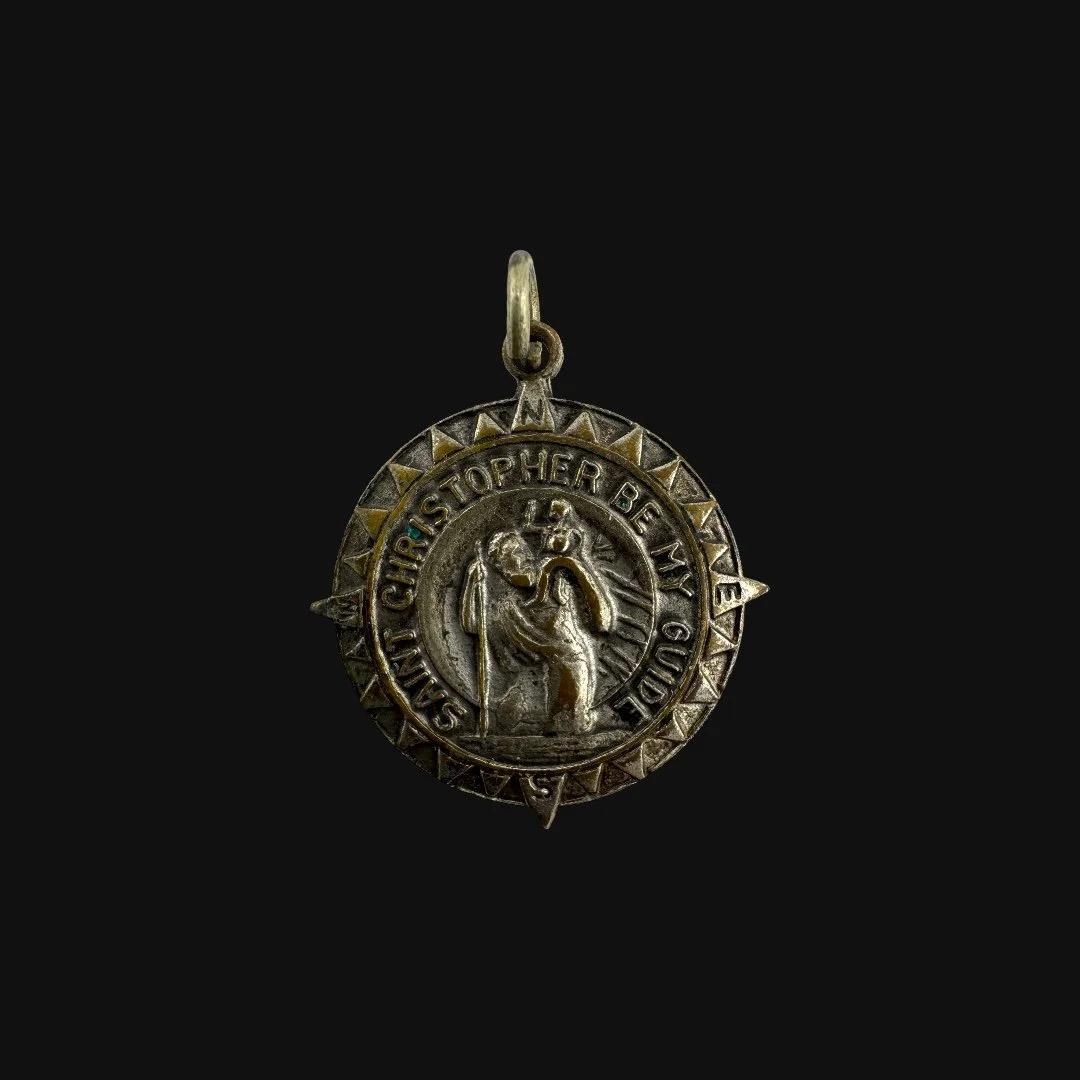 Image 1 of 10
Image 1 of 10

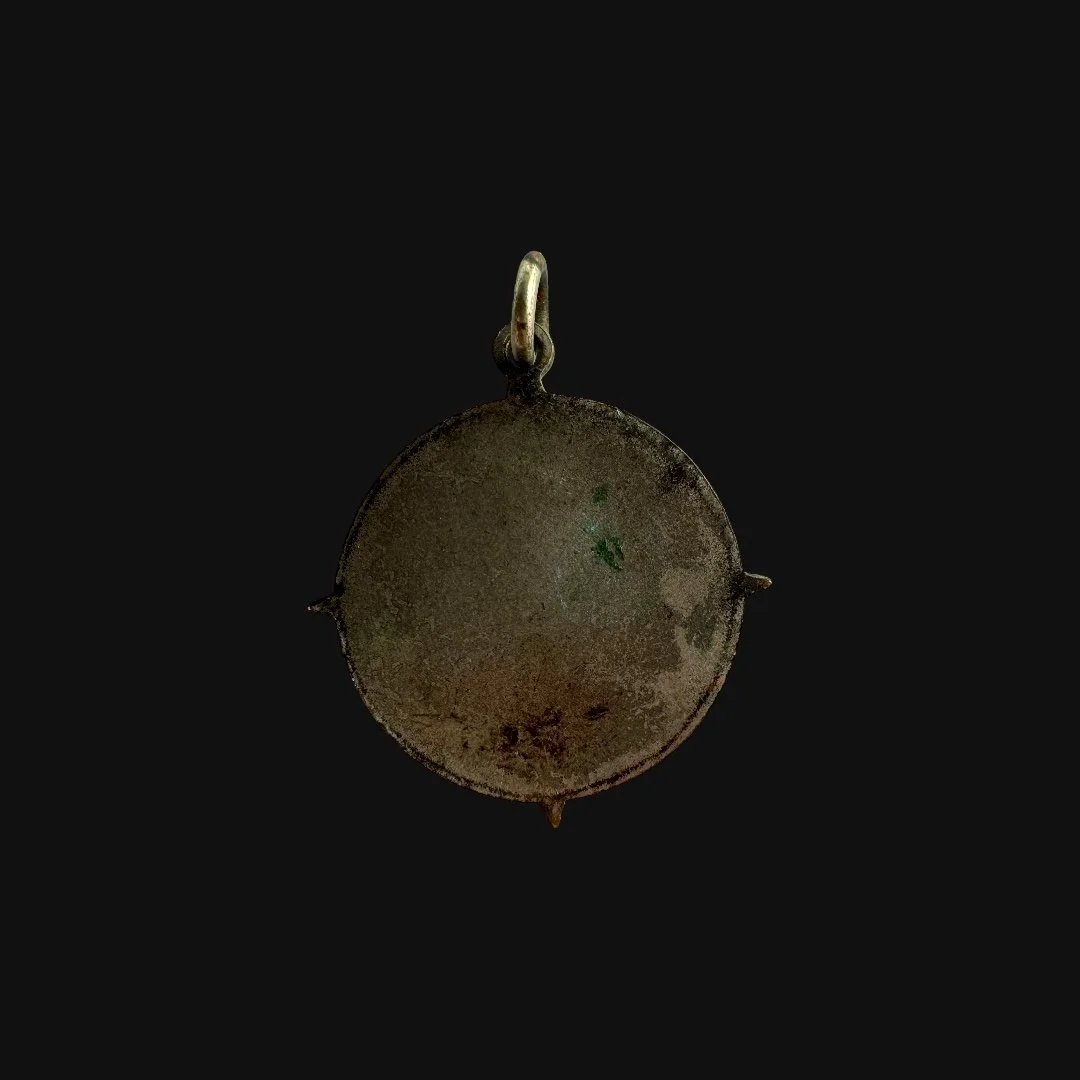 Image 2 of 10
Image 2 of 10

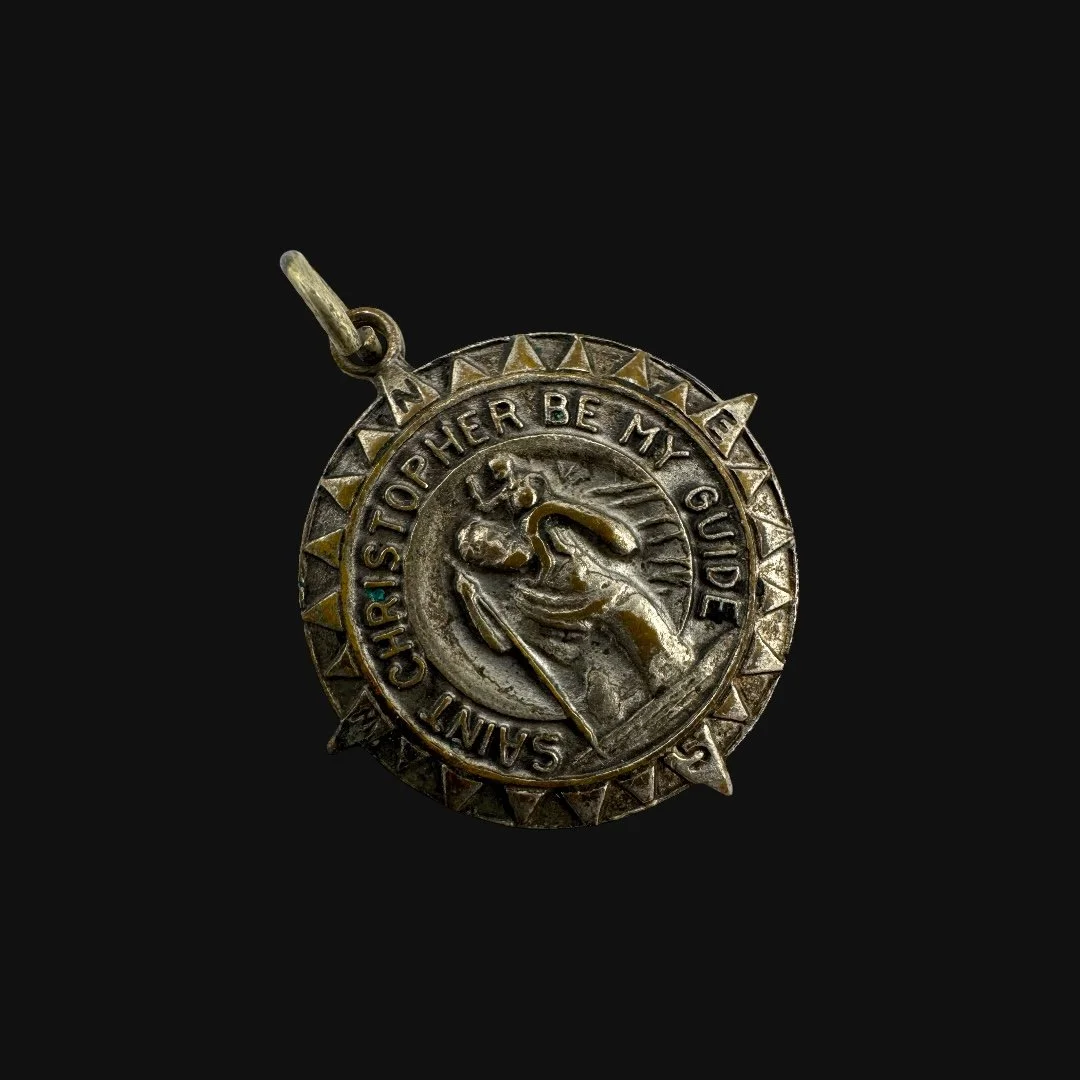 Image 3 of 10
Image 3 of 10

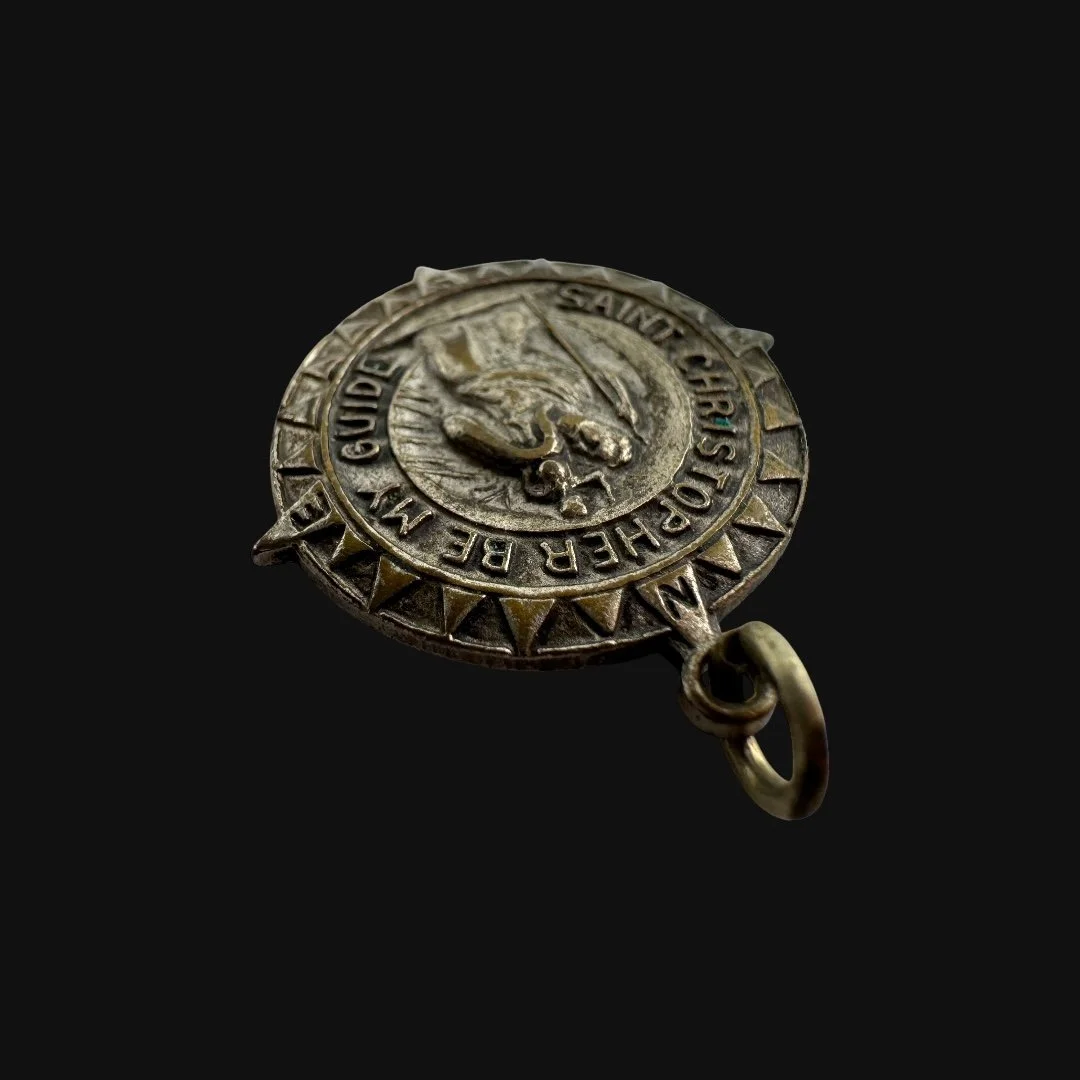 Image 4 of 10
Image 4 of 10

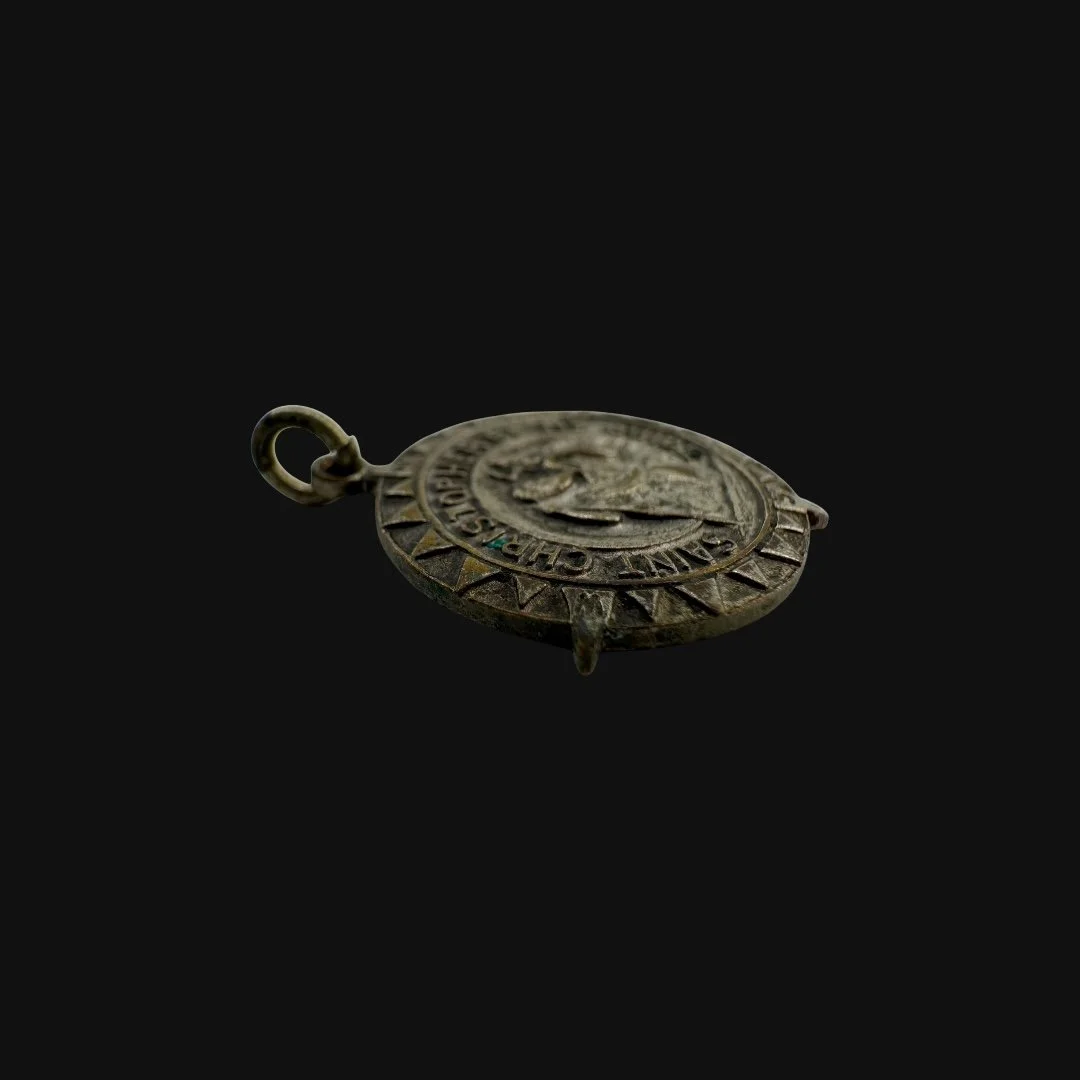 Image 5 of 10
Image 5 of 10

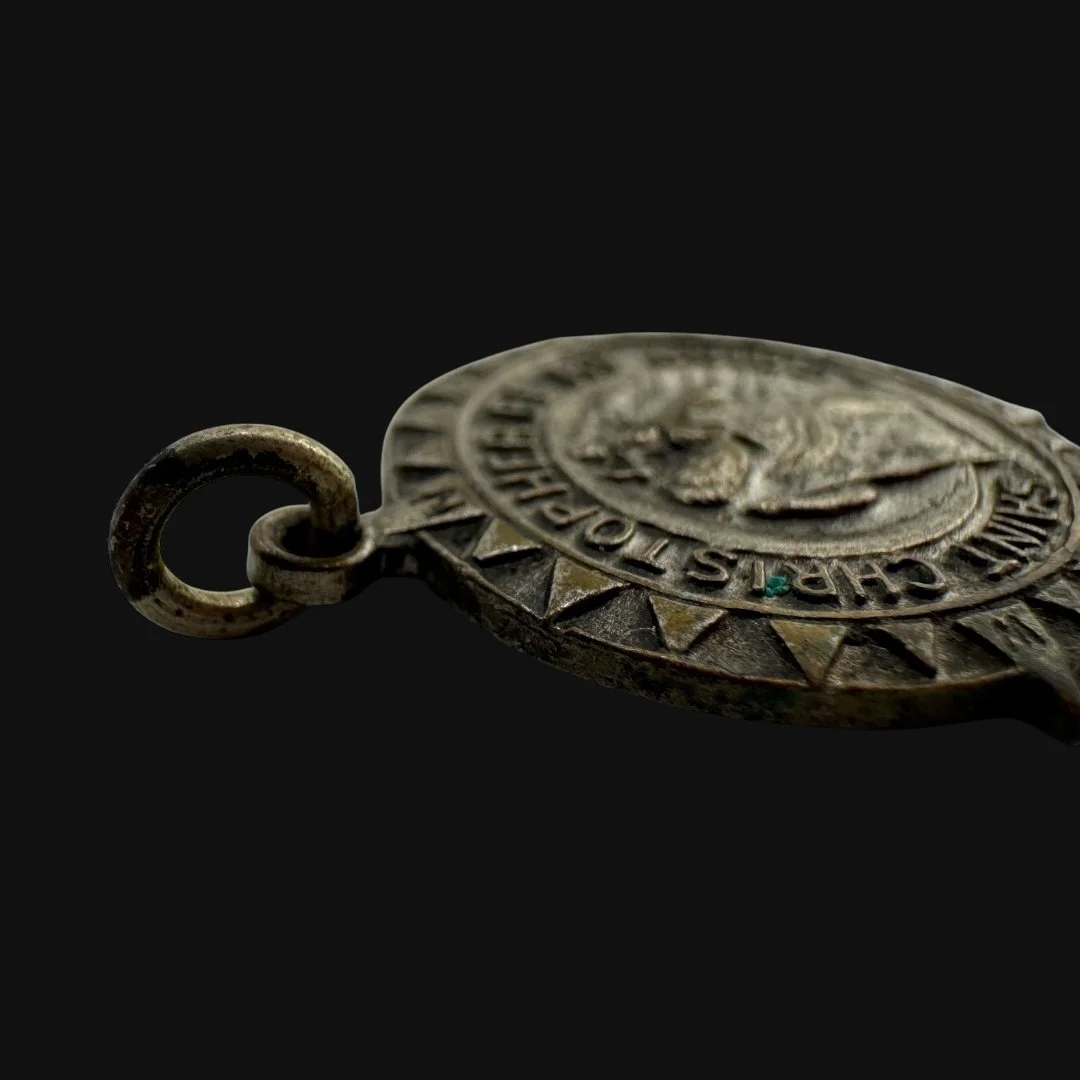 Image 6 of 10
Image 6 of 10

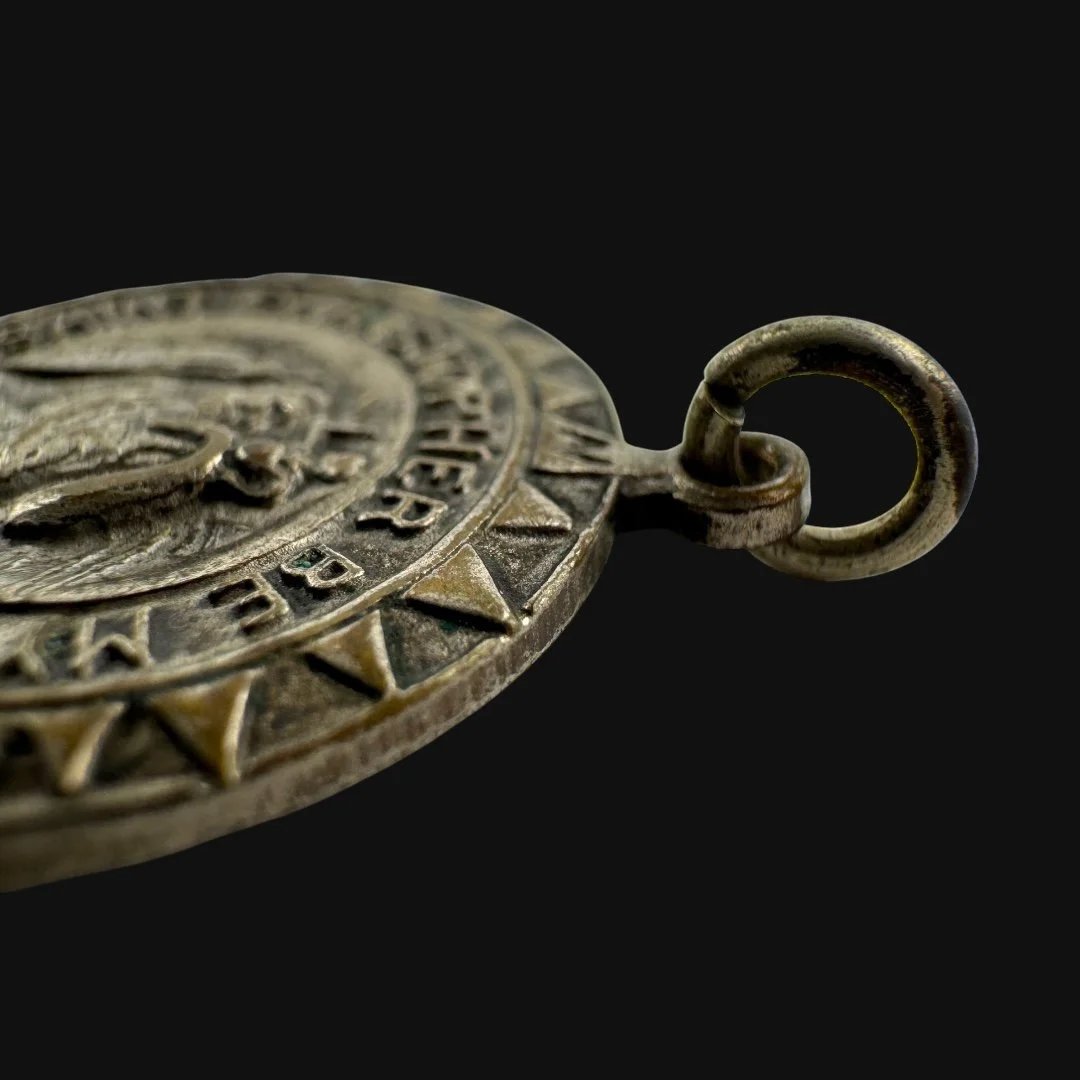 Image 7 of 10
Image 7 of 10

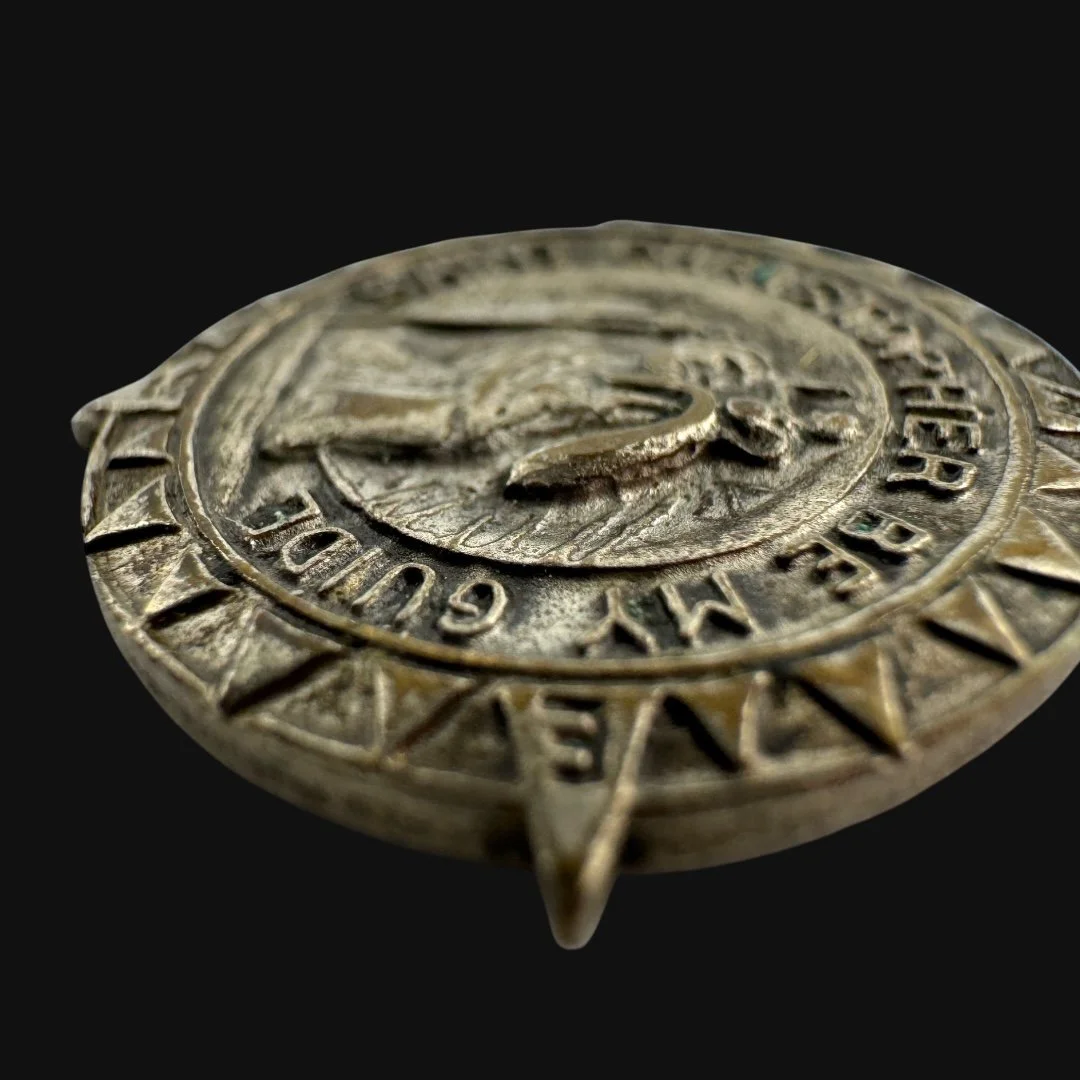 Image 8 of 10
Image 8 of 10

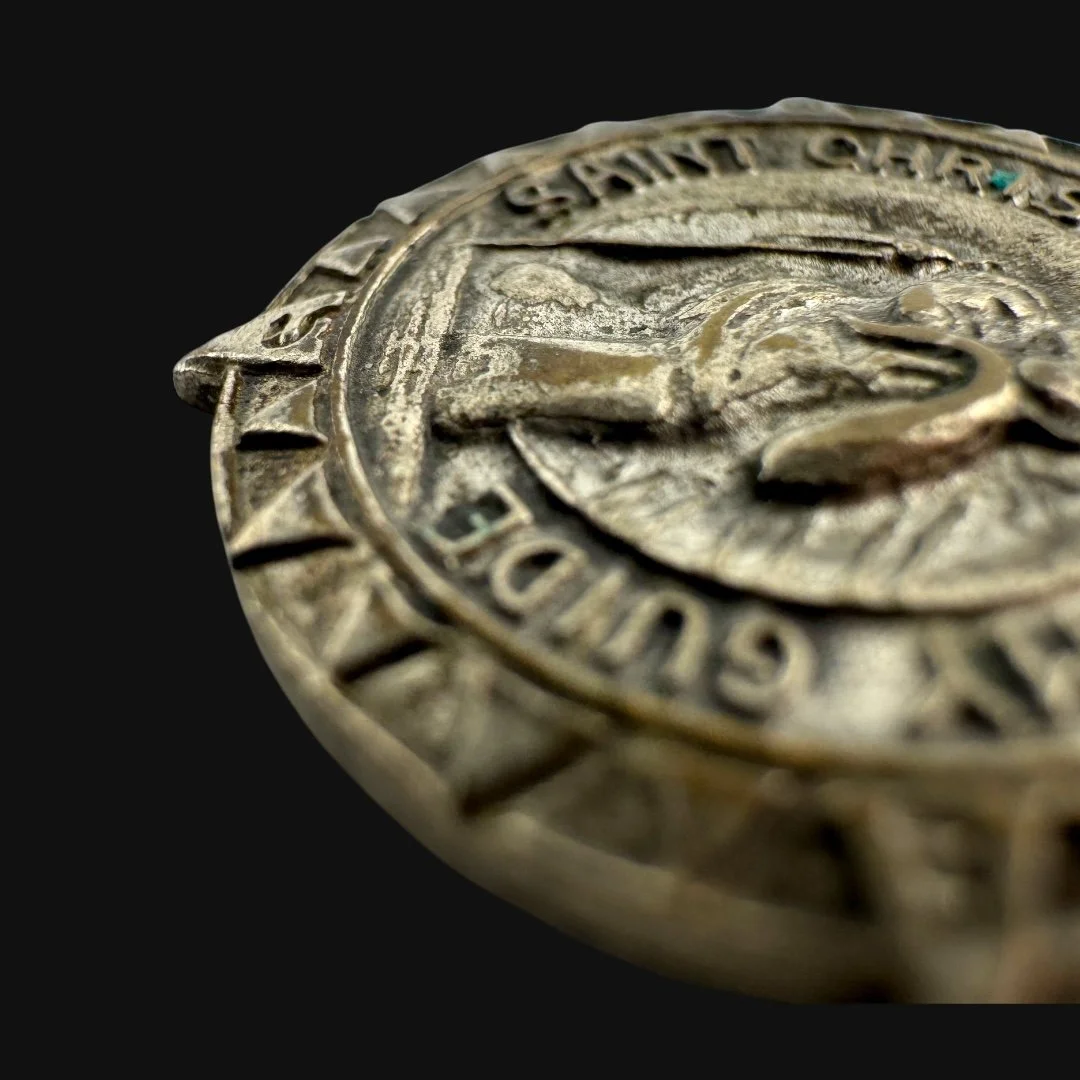 Image 9 of 10
Image 9 of 10

 Image 10 of 10
Image 10 of 10











Original WWII 1941-1945 U.S. Soldier's “Saint Christopher Be My Guide” Theater-Worn Military Religious Necklace Pendant
Comes with a hand-signed C.O.A. and a full historical research write-up
From: World War II
Dated: 1941-1945
Pendant Size: Small/Medium (19mm x 19mm)
Inscription: “Saint Christopher Be My Guide”
Wearable History Collection:
This authentic 1941-1945 WWII-era soldier’s necklace pendant, preserved in its original and unaltered condition, combines exceptional craftsmanship with lasting durability, making it fully suitable for modern wear today. As part of our exclusive World War II “Wearable History Pendant Collection,” it offers the rare opportunity to own and wear a genuine piece of World War II. Both a timeless accessory and a tangible link to the past, this truly one-of-a-kind necklace pendant stands as a wearable tribute to the courage and sacrifice of a generation.
During World War II, soldiers often carried more than rifles, rations, and uniforms into battle. Many also carried tokens of faith, love, or luck. Among the most popular religious keepsakes was the Saint Christopher pendant. This small medallion, usually made of silver or base metal, bore the image of Saint Christopher, the patron saint of travelers. For countless men and women in uniform, it became a symbol of protection, family connection, and spiritual reassurance during the chaos of war.
These religious necklace pendants were not issued by the U.S. Army, Navy, or Marine Corps. Instead, they were purchased privately. Families often gave them as gifts to sons, brothers, and husbands before they shipped overseas. Some soldiers bought them at religious supply shops, jewelry stores, or PX (Post Exchange) shops on base. By the 1940s, millions of Saint Christopher medals were produced in the United States. They came in sterling silver, nickel, or even inexpensive aluminum. They were small and discreet, making them easy to wear under a uniform or tuck into a pocket.
Although Saint Christopher is especially revered in Catholic tradition, the medals were not limited to Catholic troops. Many Protestant soldiers also wore them, either as gifts from loved ones or as general symbols of luck. In times of war, religious lines often blurred when it came to personal tokens of comfort. For some, the medal represented faith. For others, it was simply a way to feel closer to home.
The pendant carried more than religious symbolism. It was also a deeply personal link to home. Mothers gave them to sons. Sweethearts gifted them to boyfriends or fiancés. Wives sent them to husbands serving overseas. Each medal carried a story, binding a soldier to the person who had placed it around his neck.
In letters from the front, some soldiers mentioned these medals. One U.S. Army private wrote in 1944 that he “never took off” his Saint Christopher because it reminded him of his mother’s prayers. Navy sailors sometimes attached them to their dog tags. Pilots in the U.S. Army Air Forces, who faced extreme risk on bombing missions, were known to wear them tucked inside their flight jackets.
Examples in Wartime Use
D-Day Landings: Some paratroopers of the 82nd and 101st Airborne are recorded as carrying Saint Christopher medals on their jumps over Normandy. Surviving artifacts from veterans of June 6, 1944, occasionally include pendants kept through the campaign.
Pacific Theater: Marines and Navy sailors fighting in the Pacific often carried them as pocket charms. Letters from Guadalcanal and Iwo Jima mention soldiers rubbing or holding medals during moments of fear.
Air Force Missions: The mortality rate for bomber crews in Europe was among the highest in the U.S. military. Crews often brought religious medals, prayer books, or good-luck tokens aboard their aircraft. Saint Christopher pendants were among the most common.
The Legacy Within This WWII Necklace Pendant:
This original World War II soldier’s necklace pendant was worn as a symbol of faith as they faced the most dangerous campaigns of the war. From the beaches of Normandy and the frozen Ardennes to the islands of Guadalcanal and Iwo Jima, pendants like these traveled with their wearers through the fire of battle. They carried silent strength in the foxholes, aboard the landing craft, and in the skies above Europe and the Pacific. For many young men, they were reminders of family, faith, and home. Every scratch and worn edge tells a story. It reflects long marches under heavy packs, nights spent under artillery fire, and the constant weight of uncertainty. These pendants were deeply personal talismans, often gifted by loved ones, worn close to the heart through the trials of war. To own and wear an original World War II pendant today is to hold a tangible piece of that history. Each is one of a kind. No two carry the same marks, memories, or path through the war. Wearing this meaningful and historical WWII pendant is a natural conversation starter. A way to honor the service of family members who fought in the conflict and to continue carrying the legacy of the Greatest Generation forward. This pendant is not only jewelry. It is a living connection to the past. A reminder of courage, sacrifice, and the enduring spirit of those who shaped history in World War II.
Comes with a hand-signed C.O.A. and a full historical research write-up
From: World War II
Dated: 1941-1945
Pendant Size: Small/Medium (19mm x 19mm)
Inscription: “Saint Christopher Be My Guide”
Wearable History Collection:
This authentic 1941-1945 WWII-era soldier’s necklace pendant, preserved in its original and unaltered condition, combines exceptional craftsmanship with lasting durability, making it fully suitable for modern wear today. As part of our exclusive World War II “Wearable History Pendant Collection,” it offers the rare opportunity to own and wear a genuine piece of World War II. Both a timeless accessory and a tangible link to the past, this truly one-of-a-kind necklace pendant stands as a wearable tribute to the courage and sacrifice of a generation.
During World War II, soldiers often carried more than rifles, rations, and uniforms into battle. Many also carried tokens of faith, love, or luck. Among the most popular religious keepsakes was the Saint Christopher pendant. This small medallion, usually made of silver or base metal, bore the image of Saint Christopher, the patron saint of travelers. For countless men and women in uniform, it became a symbol of protection, family connection, and spiritual reassurance during the chaos of war.
These religious necklace pendants were not issued by the U.S. Army, Navy, or Marine Corps. Instead, they were purchased privately. Families often gave them as gifts to sons, brothers, and husbands before they shipped overseas. Some soldiers bought them at religious supply shops, jewelry stores, or PX (Post Exchange) shops on base. By the 1940s, millions of Saint Christopher medals were produced in the United States. They came in sterling silver, nickel, or even inexpensive aluminum. They were small and discreet, making them easy to wear under a uniform or tuck into a pocket.
Although Saint Christopher is especially revered in Catholic tradition, the medals were not limited to Catholic troops. Many Protestant soldiers also wore them, either as gifts from loved ones or as general symbols of luck. In times of war, religious lines often blurred when it came to personal tokens of comfort. For some, the medal represented faith. For others, it was simply a way to feel closer to home.
The pendant carried more than religious symbolism. It was also a deeply personal link to home. Mothers gave them to sons. Sweethearts gifted them to boyfriends or fiancés. Wives sent them to husbands serving overseas. Each medal carried a story, binding a soldier to the person who had placed it around his neck.
In letters from the front, some soldiers mentioned these medals. One U.S. Army private wrote in 1944 that he “never took off” his Saint Christopher because it reminded him of his mother’s prayers. Navy sailors sometimes attached them to their dog tags. Pilots in the U.S. Army Air Forces, who faced extreme risk on bombing missions, were known to wear them tucked inside their flight jackets.
Examples in Wartime Use
D-Day Landings: Some paratroopers of the 82nd and 101st Airborne are recorded as carrying Saint Christopher medals on their jumps over Normandy. Surviving artifacts from veterans of June 6, 1944, occasionally include pendants kept through the campaign.
Pacific Theater: Marines and Navy sailors fighting in the Pacific often carried them as pocket charms. Letters from Guadalcanal and Iwo Jima mention soldiers rubbing or holding medals during moments of fear.
Air Force Missions: The mortality rate for bomber crews in Europe was among the highest in the U.S. military. Crews often brought religious medals, prayer books, or good-luck tokens aboard their aircraft. Saint Christopher pendants were among the most common.
The Legacy Within This WWII Necklace Pendant:
This original World War II soldier’s necklace pendant was worn as a symbol of faith as they faced the most dangerous campaigns of the war. From the beaches of Normandy and the frozen Ardennes to the islands of Guadalcanal and Iwo Jima, pendants like these traveled with their wearers through the fire of battle. They carried silent strength in the foxholes, aboard the landing craft, and in the skies above Europe and the Pacific. For many young men, they were reminders of family, faith, and home. Every scratch and worn edge tells a story. It reflects long marches under heavy packs, nights spent under artillery fire, and the constant weight of uncertainty. These pendants were deeply personal talismans, often gifted by loved ones, worn close to the heart through the trials of war. To own and wear an original World War II pendant today is to hold a tangible piece of that history. Each is one of a kind. No two carry the same marks, memories, or path through the war. Wearing this meaningful and historical WWII pendant is a natural conversation starter. A way to honor the service of family members who fought in the conflict and to continue carrying the legacy of the Greatest Generation forward. This pendant is not only jewelry. It is a living connection to the past. A reminder of courage, sacrifice, and the enduring spirit of those who shaped history in World War II.